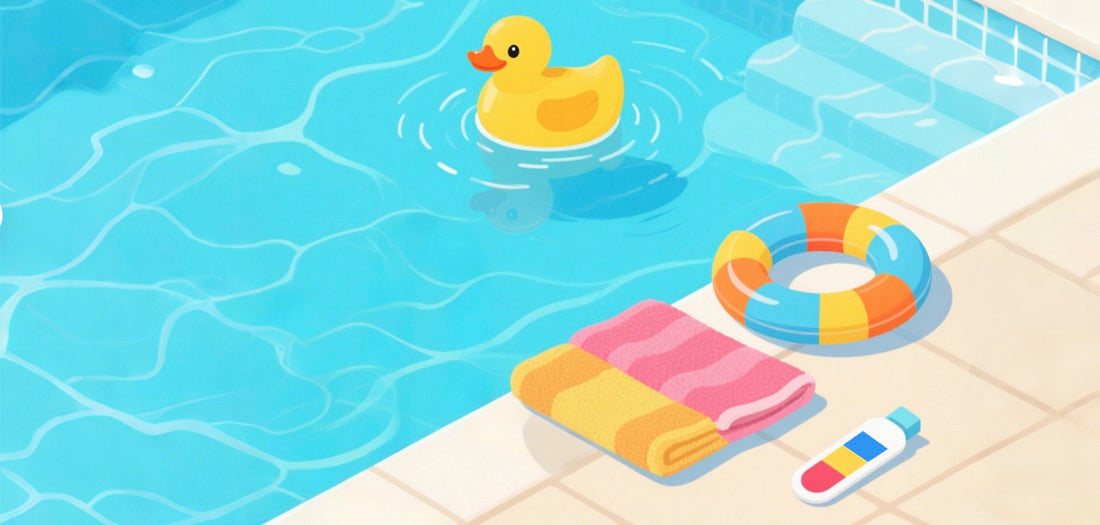
The Right Way to Use Pool Test Strips: A Simple Guide for Clear Water
Share
If you’re a pool owner, you probably know that clear water doesn’t just happen on its own. It takes the right chemicals, regular maintenance—and yes, the right tools. One of the simplest but most important tools is something you can hold in your hand: the pool test strip.
But while test strips are easy to use, many people aren’t using them correctly. And that can mean inaccurate readings, wasted chemicals, or even an unbalanced pool that’s not safe to swim in. In this guide, we’ll show you the right way to use pool test strips so you can keep your water sparkling and your swimmers happy.
Why Test Strips Matter
Test strips are like a quick health check for your pool. They help you monitor levels of key water components such as chlorine, pH, alkalinity, and more. Keeping those levels balanced not only protects your pool equipment but also keeps the water safe and comfortable for swimmers.
Unlike digital testers or professional kits, test strips are affordable, fast, and easy to use at home. But they still need to be used the right way to get accurate results.
How to Use Pool Test Strips Properly
You don’t need to be a chemist to use pool test strips. But using them the wrong way—even just slightly—can lead to inaccurate readings, which means your pool might get too much or too little of the chemicals it needs. To get accurate, reliable results every time, follow these detailed steps:
1. Grab a Clean Test Strip
Before you even open the bottle, make sure your hands are completely dry and clean. Any moisture, lotion, sunscreen, or chemical residue on your fingers can interfere with the test pad and throw off the results.
- Always close the lid on the test strip container immediately after removing one strip. Exposure to air and humidity can affect the accuracy of the rest.
- Never touch the reactive pads on the strip with your fingers.
2. Dip It Quickly Into the Pool Water
Head to your pool and dip the strip about elbow-deep into the water—this ensures you're testing water that’s more representative of the overall pool, not just the surface or near the jets.
- Submerge the strip for about 2 seconds, just enough to get the pads fully wet.
- Don’t swirl, shake, or leave the strip in too long. Extended soaking can cause the pads to absorb too much water and distort the readings.
3. Remove and Hold It Flat
Take the strip out of the water and hold it flat and level, preferably on a clean, non-absorbent surface or in your hand without tilting.
- Do not shake off excess water.
- Do not wipe the strip or blow on it to dry.
- Just hold it still and let the colors develop naturally.
4. Wait for the Colors to Develop
Each brand has a slightly different timing for color development, so check your test strip packaging. In most cases, 15 to 30 seconds is enough.
- Be consistent—start your timer or count in your head each time you test.
- Don’t wait too long; colors can continue to change and become inaccurate if you delay.
5. Compare It to the Color Chart
Match each color on the test strip to the corresponding section of the color chart on the bottle or packaging. Make sure you are doing this in good lighting, ideally natural daylight, to see the colors clearly.
- Hold the strip close to the chart, but not touching it.
- Read horizontally—don’t mix up the order of the test pads.
6. Record Your Readings If Needed
If you’re testing regularly (which you should be during pool season), keeping a log of your results is a smart idea. This helps you:
- Track trends in water chemistry
- Spot imbalances early
- Adjust chemical use more precisely
- Share accurate info with a pool service, if needed
You can use a notebook, a spreadsheet, or even an app—some test strip brands offer companion mobile apps that scan and log results automatically.
Common Mistakes to Avoid
- Dipping the strip too long
- Testing water near return jets (which may not be evenly mixed)
- Touching the test pads with fingers
- Using expired strips (yes, they do expire!)
Final Thoughts
Using test strips the right way can save you time, money, and a whole lot of frustration. It’s a small step that goes a long way toward keeping your pool water clean, balanced, and ready for fun.
So the next time you reach for that strip, remember: quick dip, flat hold, fast read. Simple as that.
